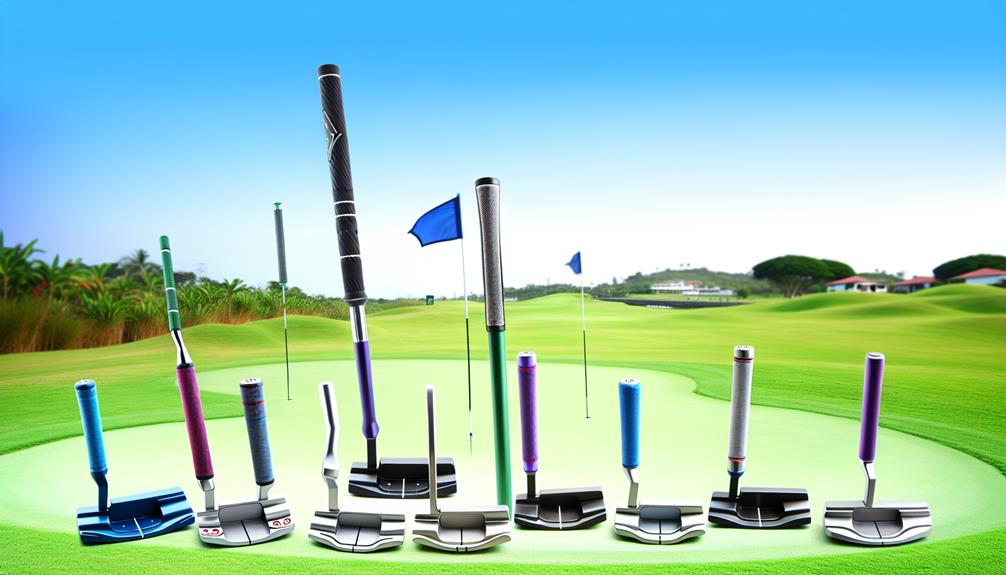Is it true that the right putter can drastically improve your golf game, especially as a beginner? You've probably heard this theory thrown around, and there's a good deal of truth to it.
As you're starting out, the multitude of putter options can seem overwhelming. It's not just about picking any club, but finding the one that feels right in your hands, aligns with your playing style, and fits your budget.
The question is, how do you sift through the noise to find that perfect beginner's putter? We're about to embark on a journey that will demystify this process, giving you the confidence to make an informed decision.
But beware, once you master this, there's no telling where your golfing skills might lead you.
Understanding Golf Putters Basics
Diving into the basics of golf putters, you need to understand that these essential clubs come in a variety of shapes, sizes, and styles, each designed to enhance a specific aspect of your short game. Let's talk putter types.
You've got blade putters, mallet putters, and peripheral-weighted putters. Blades are traditional, thin, and flat—ideal for 'feel' putters with a putting technique that's straight back and straight through. Mallets, on the other hand, are larger, often rounded in shape, and perfect for golfers who need a bit more guidance in their stroke. Peripheral-weighted putters combine the best of both worlds, providing extra alignment aid and improved balance.
Your putting technique strongly influences which putter is right for you. A golfer with a straight stroke might prefer a blade, while one with an arcing stroke might find a mallet more suitable. Additionally, your preferred ball contact, whether it's a soft touch or a firm hit, also matters.
Features of a Good Beginner's Putter
Now that you're familiar with the various types of golf putters and how your putting style influences your choice, let's explore the specific features that make a putter suitable for a beginner.
Firstly, putter materials play a crucial role. Beginners usually benefit from a putter made of softer materials like polymer or rubber. These materials absorb shock better, making for a smoother putting experience. They also provide better feedback, helping you understand how well you've hit the ball.
Next, let's talk about grip choices. As a beginner, picking the right grip can significantly impact your control and comfort. Large or jumbo grips are recommended for starters. They take your wrists out of the equation, promoting a more controlled stroke powered by your shoulders. Plus, they reduce hand pressure, making you less likely to 'choke' during a putt.
Also, look for putters with alignment aids. These could be lines or contrasting colors on the clubhead, helping you line up your putts more accurately.
Lastly, always consider the length. It should allow you to maintain a comfortable posture, with your eyes directly over the ball. Remember, finding the right putter isn't about picking the most expensive one, but the one that best fits your needs.
Top Five Beginner Golf Putters
Let's delve into the top five golf putters that are perfect for beginners, carefully chosen for their beginner-friendly features and excellent performance.
- The Wilson Harmonized Square Heel/Toe Putter: This putter is top on our list due to its exceptional balance and alignment aids, perfect for honing beginner's putting techniques.
- The Pinemeadow Golf Men's PGX Putter: It's known for its high contrast alignment design that assists in maintaining a straight putt.
- The Odyssey White Hot Pro 2.0 Putter: This one stands out with its consistent feel and responsiveness, making it a great investment for beginners.
- The Quolf Golf Two-Way Putter: Ideal for those who haven't determined their playing hand yet. It's ambidextrous, allowing you to practice with both hands.
- The Callaway Golf 2021 White Hot OG Putter: It's a bit pricier but offers advanced technology that can aid in improving your game.
Each putter has its unique benefits, and putter price comparison is important in choosing the right one for you. Remember, the goal is to find a putter that helps you master the fundamentals of the game without breaking the bank.
How to Test Your Golf Putter
After selecting the right putter from our top five list, it's crucial to know how to properly test your golf putter to ensure it truly fits your style and skill level.
Start by taking note of the putter's weight. It shouldn't feel too heavy or too light in your hands.
Next, consider putter adjustments. A fitting session can help determine the right length, loft, and lie angle for your unique stance and swing. Don't hesitate to tweak these variables until you find the perfect balance.
Testing your putter also involves analyzing your putting techniques. Pay attention to your grip, stance, and alignment. Are you more comfortable with a traditional, cross-handed, or claw grip? Does your putter encourage a square or open stance? Do you naturally aim left, right, or straight at the target?
Maintaining Your Golf Putter
Once you've found the perfect putter and mastered your technique, it's crucial to properly maintain your golf putter to ensure its longevity and performance. Here are some putter cleaning tips and storage methods to keep your putter in top-notch condition.
First, regular cleaning is essential. Use a soft, damp cloth to wipe down the putter after each game. Avoid abrasive cleaners that can scratch or damage the putter. Further, it's a good idea to lightly oil the putter's head occasionally to prevent rusting.
Secondly, consider your putter storage methods. Don't just toss your putter in your golf bag with other clubs. This can lead to scratches and other damage. Instead, use a headcover to protect your putter when not in use.
Lastly, store your putter in a cool, dry place. Extremes of heat or humidity can warp the putter or cause other damage.

